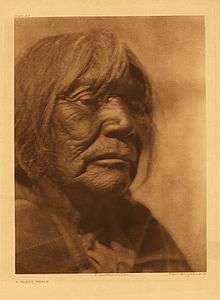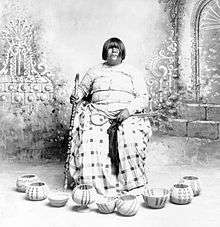Washoe people
 Washoe tribal flag | |
| Total population | |
|---|---|
| (1,500 (2007)[1]) | |
| Regions with significant populations | |
|
( | |
| Languages | |
| English, Washo[1] | |
| Religion | |
| traditional tribal religion |
The Washoe are a Great Basin tribe of Native Americans, living near Lake Tahoe at the border between California and Nevada.[1] The name "Washoe" is derived from the autonym waashiw (wa·šiw) meaning "people from here" in the Washo language (transliterated in older literature as Wa She Shu (Wašišiw) the plural form of wašiw).
Territory
Washoe people have lived in the Great Basin and the eastern Sierra Nevada mountains for at least the last 6,000 years.[2] Prior to contact with Europeans, the territory of the Washoe people was roughly bounded by the southern shore of Honey Lake in the north, the west fork of the Walker River in the south, the Sierra Nevada crest in the west, and the first range east of the Sierra Nevada in the east. The Washoe would generally spend the summer in the Sierra Nevada, especially at Lake Tahoe; the fall in the ranges to the east; and the winter and spring in the valleys between them.
History

Washoe people are the only Great Basin tribe whose language is not Numic, so they are believed to have inhabited the region prior to neighboring tribes. The Kings Beach Complex that emerged about 500 CE around Lake Tahoe and the northern Sierra Nevadas are regarded as early Washoe culture. The Martis complex may have overlapped with the Kings Beach culture, and Martis pit houses gave way to conical bark slab houses of historic Washoe culture.[3]
The Washoe people and the neighboring Northern Paiute people were culturally and linguistically very different, and they sometimes came into conflict and were often enslaved by them.
Washoe people may have made contact with Spanish explorers in the early 19th century, but the Washoe did not sustain contact with people of European culture until the 1848 California Gold Rush.[2] Washoe resistance to incursions on their lands proved futile, and the last armed conflict with the Washoes and non-Indians was the Potato War of 1857, when starving Washoes were killed for gathering potatoes from a European-American farm near Honey Lake in California.[4]
Loss of the valley hunting grounds to farms and the piñon pine groves to feed Virginia City's demand for lumber and charcoal drove most Washoe to dependency on jobs on white ranches and farms and in cities. The areas where they settled became known as Indian colonies.
Culture

Piñon pine nuts gathered in the fall provided much of the food eaten in the winter. Roots, seeds, berries and game provided much of the food eaten during the rest of the year. The Washoe people were also deeply knowledgeable about their land and where resources were plentiful. This included an understanding of the seasonal cycles of both plants and animals. Wašiw people were also dependent on fishing at Lake Tahoe and the surrounding streams. Fishing was a huge part of Wašiw life; and each family had its own fishing grounds, until contact with western civilization led to commercial fishing in the area, destroying another important resource for the Wašiw.[5]
The Pine Nut Dance and girls' puberty rites remain very important ceremonies.[6] The Wašiw people once relied on medicine men and their innate knowledge of medicinal plants and ceremonies. Much of this knowledge and activity has been lost due to contact with the Western world and practices enacted by the Federal government with the intent to destroy the Wašiw way of life.
Language
The Washoe language has been regarded as a language isolate,[1][7] However, it is sometimes tentatively regarded as part of the controversial Hokan language family.[8] The language is written in the Latin script.[1]
The Wašiw language is now considered a moribund language as only a handful of fluent elder speakers use the language. There has been a recent revival of the language and culture within the Tribe. "Wašiw Wagayay Maŋal" (the "house where Wašiw is spoken") was the first attempt by the Wašiw people to renew their language for the future generations. The tribe currently relies on the tribal Cultural Resource Department to provide language classes to the community. However, there has recently been a pedagogical shift within the tribe, and the youth have become the focal point of language and culture programs, because they are the future.
Washoe tribes
Under the Indian Reorganization Act of 1934, the colonies in the Carson Valley area of Nevada and California gained federal recognition as the Washoe Tribe of Nevada and California. The colony in Reno, Nevada, which also had a substantial Paiute and Shoshoni population, gained separate recognition as the Reno-Sparks Indian Colony. There is evidence that some Washoe settled in the southwest region of Montana. The Susanville Rancheria includes Washoe members, as well as Northern Paiute, Northeastern Maidu, Achomawi, and Atsugewi members.[10]
Notes
- 1 2 3 4 5 "Washo." Ethnologue. Accessed May 9, 2014.
- 1 2 Pritzker 246
- ↑ D'Azevedo 466
- ↑ D'Azevedo 494
- ↑ Dangberg 1968, d'Azevedo 1986, Nevers 1976
- ↑ Pritzker, 246, 248
- ↑ "Washoe Indian Tribe History." Access Genealogy. Retrieved 11 May 2010.
- ↑ Pritzker 220
- ↑ Pritzker 248
- ↑ "California Indians and Their Reservations." SDSU Library and Information Access. (retrieved 11 May 2010)
References
- Dangberg, Grace. 1968. Washo Tales: Three Original Washo Indian Legends. Nevada State Museum Occasional Paper Number 1. Carson City, Nevada.
- d'Azevedo, Warren L. (1986). "Washoe" in Great Basin, Warren L. d'Azevedo, ed. pp. 466–498. Volume 11 in Handbook of North American Indians, William C. Sturtevant, general editor. Washington, DC: Smithsonian Institution. ISBN 0-16-004578-9/0160045754.
- Nevers, Jo Ann. 1976. Wa She Shu: A Washo Tribal History. Inter-Tribal Council of Nevada: University of Utah Printing Service.
- Pritzker, Barry M. A Native American Encyclopedia: History, Culture, and Peoples. Oxford: Oxford University Press, 2000. ISBN 978-0-19-513877-1.
Further reading
- Barett, Samuel Alfred (1917). The Washo Indians. Pub. by order of the Trustees. Retrieved 24 August 2012.
- Washo Bibliography, from California Indian Library Collections Project
External links
| Wikimedia Commons has media related to Washo. |
- Washoe Tribe of Nevada and California, official website
- Reno-Sparks Indian Colony, official website
- Susanville Indian Rancheria, official website
| ||||||